or how to “skillfully” spread false (fake) informationLast week, the Lithuanian Radio and Television Commission (Lithuanian Radio and Television CommissionIt seems like your message is incomplete. Could you please provide the text you would like me to translate?“prohibited”The broadcast of the Russian TV channel RT in the Republic of Lithuania has been halted due to its connections with the Russian propagandist Dmitry Kiselev, who is on the European Union’s “blacklist” and is considered the ultimate beneficiary. This follows the channel’s ban in Latvia.It seems like your request is incomplete. Could you please provide the text you would like me to translate?When bans on broadcast or cable television channels occur, the audiences of the corresponding channels’ websites and their YouTube channels often increase. This fact should be taken into account by decision-makers responsible for imposing bans, as they need to be aware of audience changes, i.e., consider the migration of viewers in media consumption.
The global audience of the RT.com website is enormous. According to research company comScore, even four years ago, the audience…The word “достигала” translates to “reached” or “achieved” in English, depending on the context. If you have a specific sentence or context in which this word is used, please provide it for a more accurate translation. 50 million“person. The audience in the USA alone, considering the website, mobile app, and YouTube channel, amounted to over”9 millionA person. Individual materials on the site gather an unreal amount of social empathy manifestations—hundreds of thousands and even millions of likes and shares. According to the social media monitoring service Buzzsumo, the posts with the highest engagement on Facebook.com over the past year are:
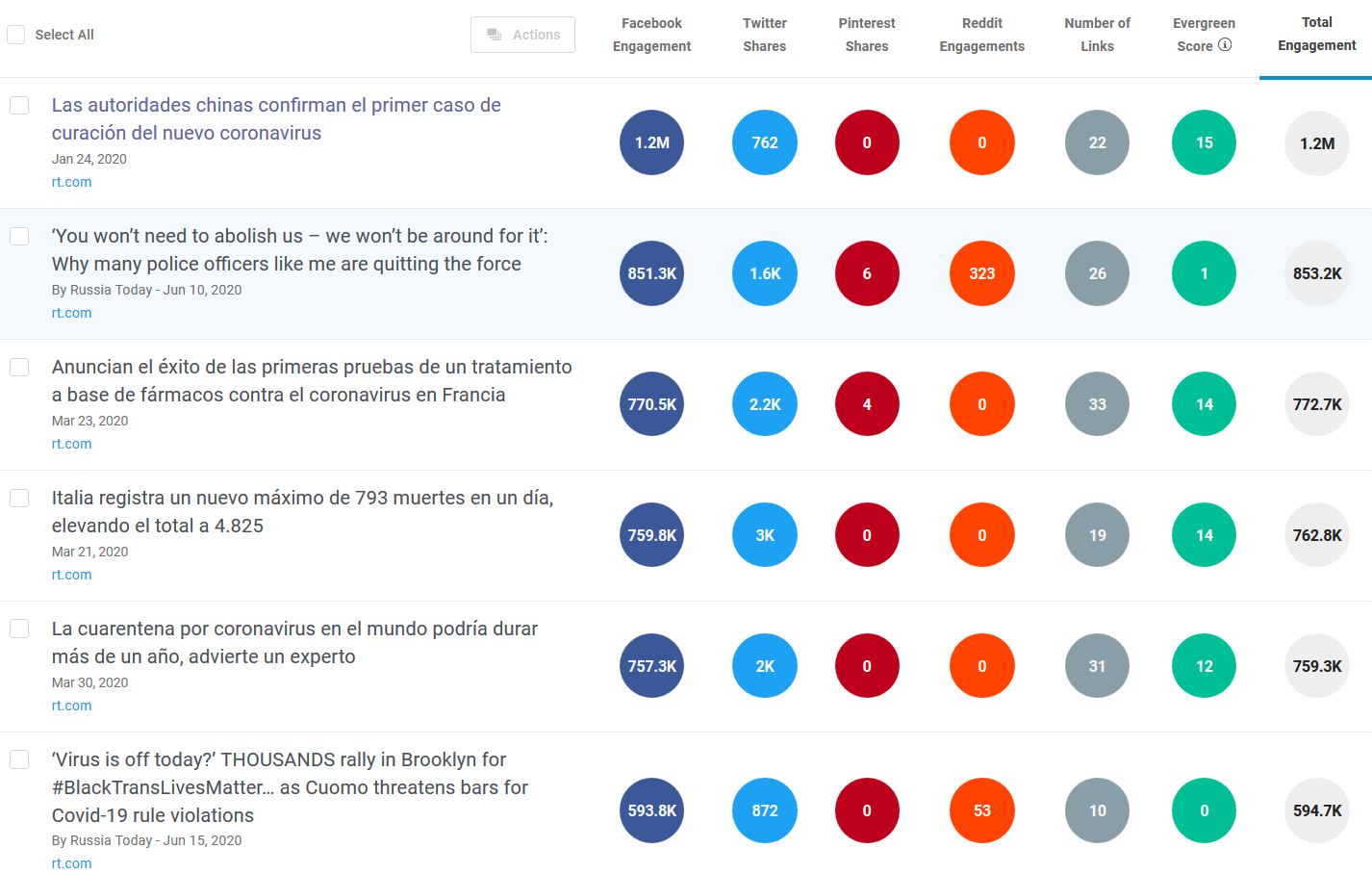 It should be noted that the topics of the publications presented are the coronavirus pandemic COVID-19, particularly in Italy and France, and the second topic is the June protests in the United States. As a recent study shows,Oxford Internet InstituteContent on social media related to the coronavirus published by “RT” and “Sputnik” in Germany, Spain, and France may receive a higher average number of interactions per post than that of reputable media outlets.It seems that your message is empty. Could you please provide the text you would like me to translate?Now let’s turn to the analysis of the Belarusian desktop audience of the website russian.rt.com. The audience during the first half of 2020:
It should be noted that the topics of the publications presented are the coronavirus pandemic COVID-19, particularly in Italy and France, and the second topic is the June protests in the United States. As a recent study shows,Oxford Internet InstituteContent on social media related to the coronavirus published by “RT” and “Sputnik” in Germany, Spain, and France may receive a higher average number of interactions per post than that of reputable media outlets.It seems that your message is empty. Could you please provide the text you would like me to translate?Now let’s turn to the analysis of the Belarusian desktop audience of the website russian.rt.com. The audience during the first half of 2020:
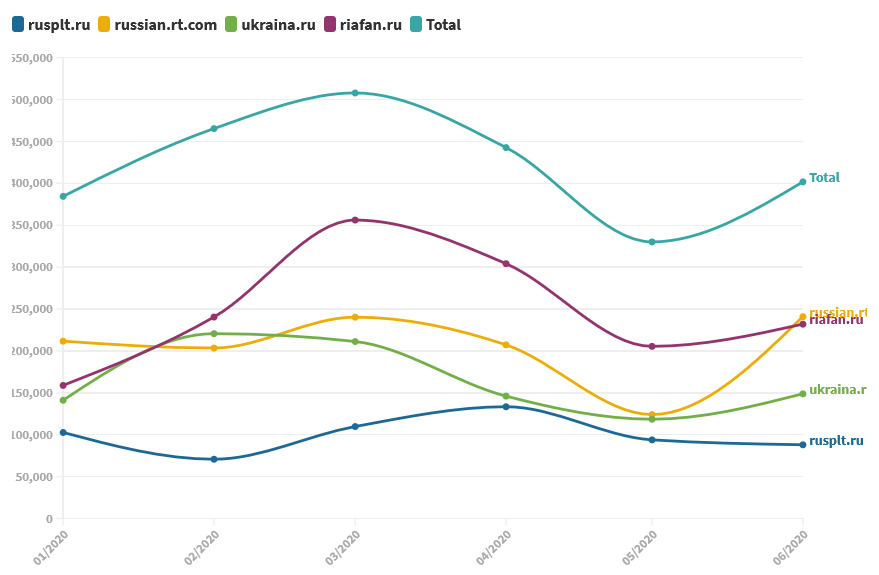 In June 2020, the readership of the website russian.rt.com amounted to240 thousanda person who allows to be almost in the middle of the first hundred popular (by reach) websites in Belarus:
In June 2020, the readership of the website russian.rt.com amounted to240 thousanda person who allows to be almost in the middle of the first hundred popular (by reach) websites in Belarus:
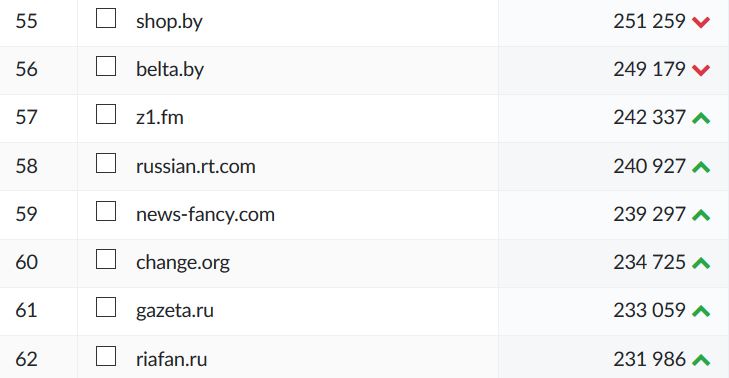 The main socio-demographic characteristics of the Belarusian online audience aged 15-74 for the website russian.rt.com show that the share of the male audience fluctuated from 49% (June 2020) to 69% (February 2020), while the female audience ranged from 31% (February 2020) to 51% (June 2020).
The main socio-demographic characteristics of the Belarusian online audience aged 15-74 for the website russian.rt.com show that the share of the male audience fluctuated from 49% (June 2020) to 69% (February 2020), while the female audience ranged from 31% (February 2020) to 51% (June 2020).
The young audience aged 15-24 peaked at 12.3% in April 2020. For those aged 25-34, the maximum share was 19% in May 2020. The largest proportion of individuals aged 35-44 was recorded in January 2020 at 15%. The two largest reader groups are those aged 45-54 and 55-74. The peak for the 45-54 age group occurred in April 2020, reaching 32%. The 55-74 age group fluctuated between 33% (January 2020) and 43% (May 2020). The two largest occupational categories are specialists/chief specialists (16-21%) and retirees (18-24%), which correlates with the readers’ age. The audience from Minsk shows significant fluctuations, ranging from 40,000 (May 2020) to 80,000 (March 2020). The share of people from small towns (up to 50,000 residents) and rural areas remains relatively stable at 22%. In large industrial cities that are not regional centers, the share is 18-21%. Additionally, 60% of the audience watches traditional television every day.
The behavior of the Belarusian online audience on russian.rt.by, including which other resources were visited over the month and the share of readers from rt.com among the audiences of other websites:
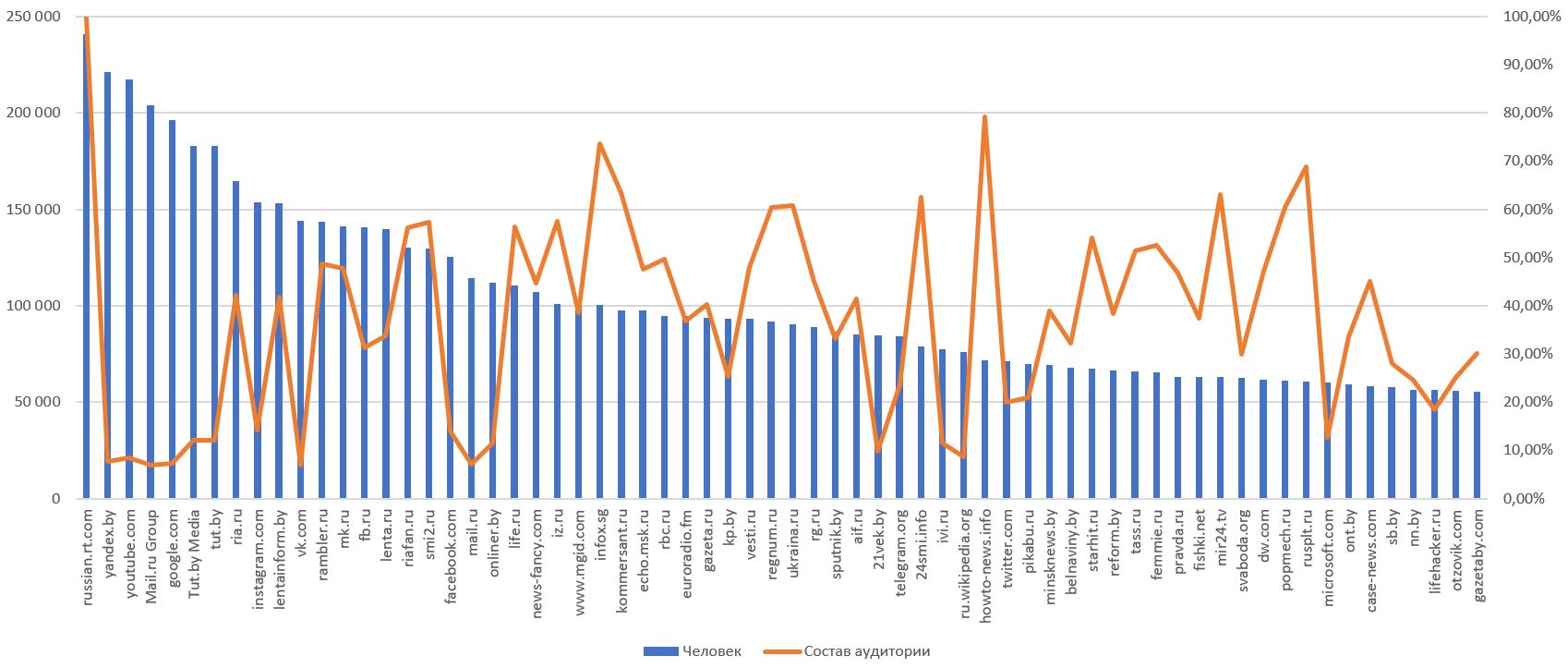 The largest audience overlaps with Russian news websites and aggregators are howto-news.info (79.2%), infox.sg (73.6%), and rusplt.ru (69%).
The largest audience overlaps with Russian news websites and aggregators are howto-news.info (79.2%), infox.sg (73.6%), and rusplt.ru (69%).
Let’s take a look at the content of the news feed on russian.rt.com, particularly the news about Belarus. Of course, the link to this section distorts the official spelling of the name of Belarus – https://russian.rt.com/trend/334987-belorussiya. Another more subtle reference to the legacy of the Soviet Union is the section “Former USSR” – https://russian.rt.com/The term “USSR” stands for the “Union of Soviet Socialist Republics,” which was a socialist state that existed from 1922 to 1991, encompassing much of Eastern Europe and Northern Asia. It was a federation of multiple republics, with Russia being the largest and most influential. The USSR was known for its centralized government, planned economy, and significant role in global politics during the Cold War era.The incorrect term “Baltics” is used to refer to the Baltic States. Aggressive headlines in news sections related to Ukrainian news…
When you visit the site russian.rt.com, you are kindly offered to download Yandex.Browser: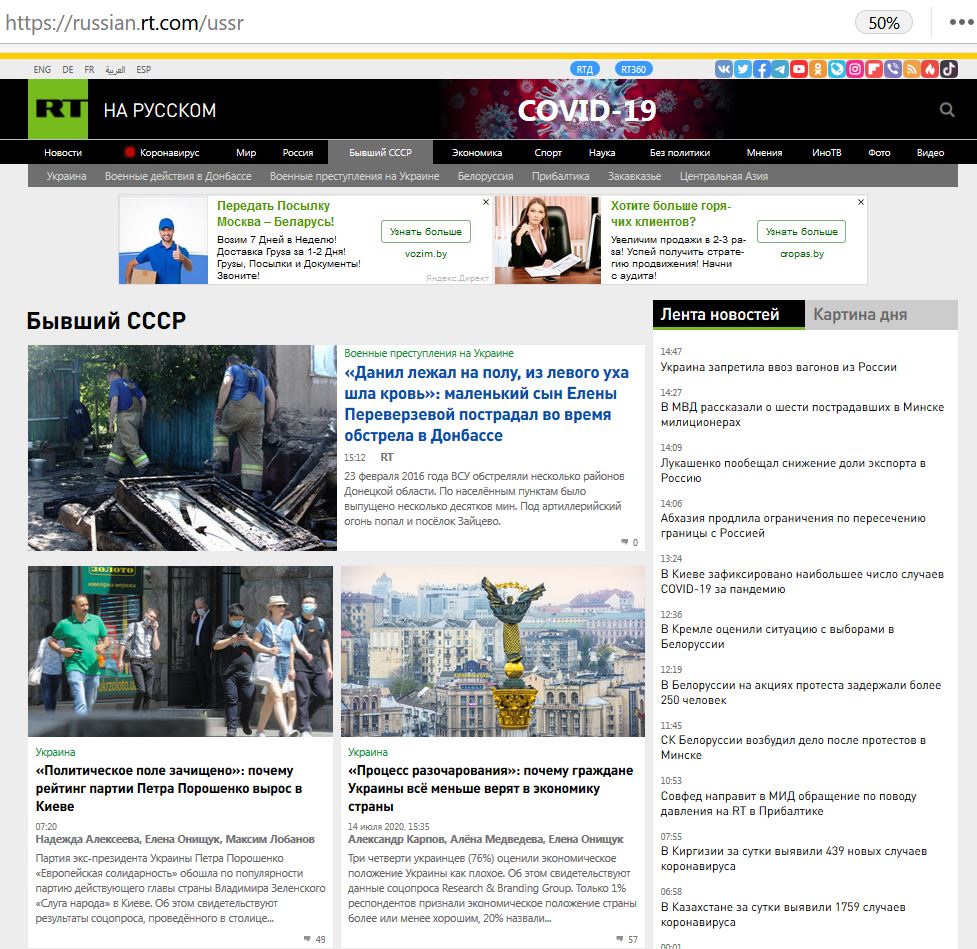 This “courtesy” is clearly visible in the referral traffic sources for the website russian.rt.com, according to data from SimilarWeb:
This “courtesy” is clearly visible in the referral traffic sources for the website russian.rt.com, according to data from SimilarWeb:
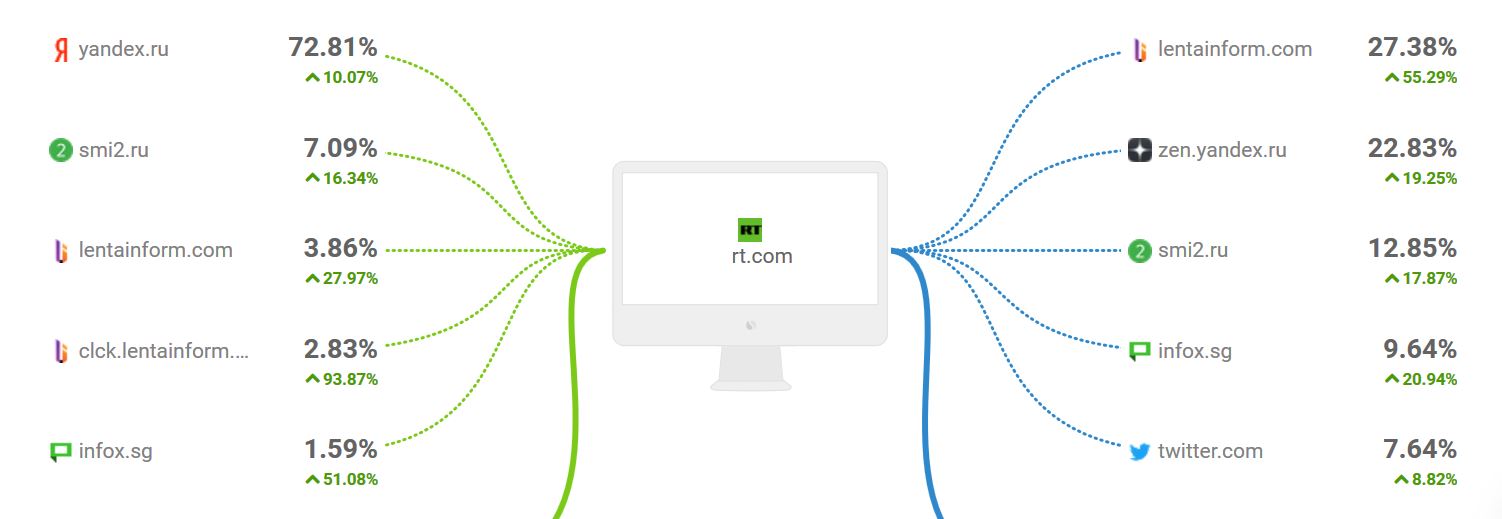 That is, the traffic comes from the Russian search engine yandex.ru and goes to the content recommendation system – Yandex.Zen. There are also blocks of contextual advertising – Yandex.Direct. Additionally,“used”The native advertising platform Taboola, which takes into account user behavior, location, context, social trends, and other factors, allows for the personalization of online advertising. It is worth looking at other major sources favored by media managers for traffic—news aggregators. They are very visually appealing and harmoniously arranged, in terms of design, on the pages of websites:
That is, the traffic comes from the Russian search engine yandex.ru and goes to the content recommendation system – Yandex.Zen. There are also blocks of contextual advertising – Yandex.Direct. Additionally,“used”The native advertising platform Taboola, which takes into account user behavior, location, context, social trends, and other factors, allows for the personalization of online advertising. It is worth looking at other major sources favored by media managers for traffic—news aggregators. They are very visually appealing and harmoniously arranged, in terms of design, on the pages of websites: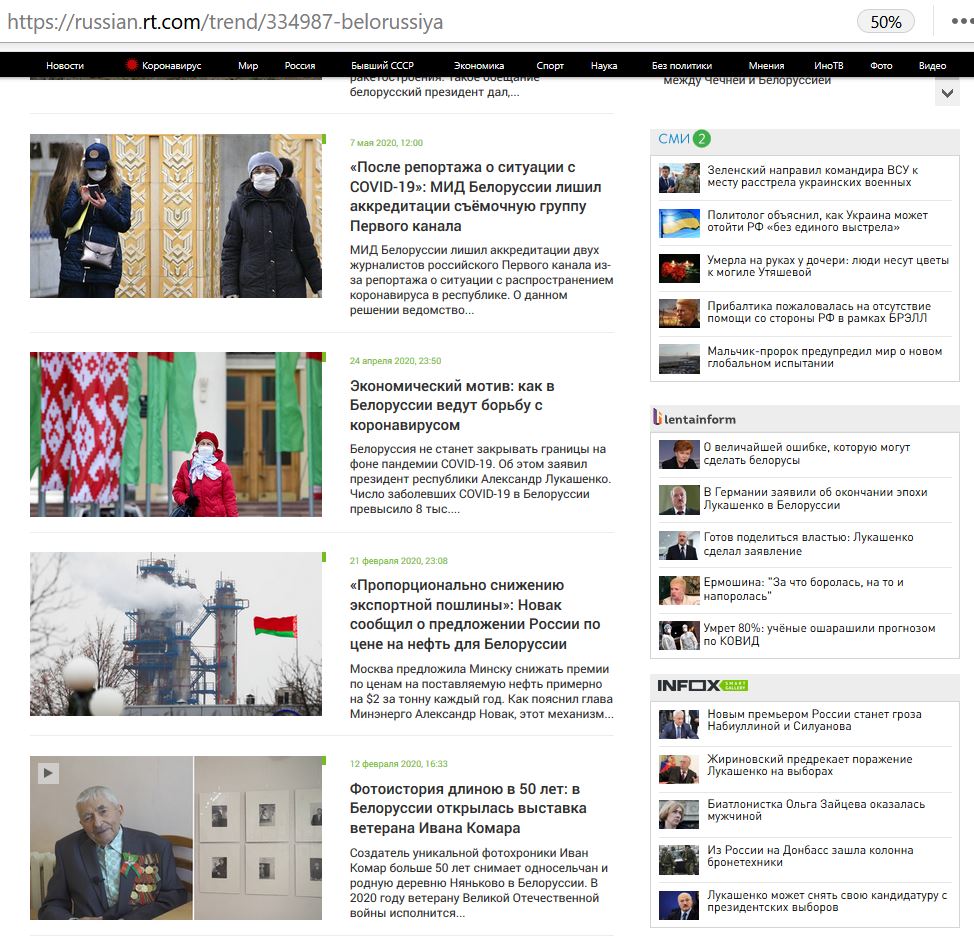 That is, the traffic comes from the Russian search engine yandex.ru and goes to the content recommendation system – Yandex.Zen. There are also blocks of contextual advertising – Yandex.Direct. Additionally,“used”The native advertising platform Taboola, which takes into account user behavior, location, context, social trends, and other factors, allows for the personalization of online advertising. It is worth looking at other major sources favored by media managers for traffic—news aggregators. They are very visually appealing and harmoniously arranged, in terms of design, on the pages of websites:
That is, the traffic comes from the Russian search engine yandex.ru and goes to the content recommendation system – Yandex.Zen. There are also blocks of contextual advertising – Yandex.Direct. Additionally,“used”The native advertising platform Taboola, which takes into account user behavior, location, context, social trends, and other factors, allows for the personalization of online advertising. It is worth looking at other major sources favored by media managers for traffic—news aggregators. They are very visually appealing and harmoniously arranged, in terms of design, on the pages of websites:Very bright headlines, striking photographs, and where do they lead? In particular, a sensitive headline on the topic of the COVID-19 coronavirus pandemic.Chilling forecast from scientists: 80% of humanity will die from the coronavirus.“This publication is false information, i.e.”“fake”It seems that your message is incomplete. Could you please provide the text you would like me to translate?“Disinformation”“as it distorts the original article”Immunity to Covid-19 may diminish within months, according to a study conducted in the UK.“This case is described in detail.”“Here”Let’s check the version that people do not pay attention to unreliable information and clickbait headlines and do not click on these news sources. The Belarusian computer audience on smi2.ru in June 2020 was226 thousand“Person. The total with russian.rt.com (taking into account audience overlap) -“337 thousand“Man. That is to say”129 thousandDuring the month, individuals visited both resources. Among them, women aged 55-74 accounted for 38,700 people, while men in the same age group numbered 26,100. There were 28,200 women aged 45-54 and 18,600 men in that age range. In terms of occupation, there were 31,000 specialists/chief specialists, 12,000 skilled workers/foremen, and 41,000 retirees. In Minsk, there are 39,200 people. In small towns and rural areas, the number is 31,000. Additionally, there are 20,500 in large industrial cities.
Now, let’s take the next aggregator – Lentainform, which had a fake news story about COVID-19. The Belarusian audience of Lentainform.by in June amounted to…366 thousand“Person. General audience from russian.rt.com (taking into account audience overlap) -“453 thousand“person. Has visited both resources -“153 thousandThe distribution by age is as follows:
women aged 55-74 – 51 thousand people;
men aged 55-74 – 29 thousand people;
women aged 45-54 – 38 thousand people;
men aged 45-54 – 23 thousand people.
There are 51 thousand retirees, 33 thousand specialists/chief specialists, 10.5 thousand middle management leaders, and 14.5 thousand skilled workers/foremen in production.
In Minsk, there are 39.7 thousand people, in small towns there are 37 thousand people, and 31 thousand in large industrial cities.
The third aggregator is infox.sg. The audience for June is –136 thousand“Person. General audience.”276 thousand“People. Those who have visited both resources – “100 thousandthe demographic. Among them, there are 40,000 women aged 55-74, and 16,000 men in the same age group. Women aged 45-54 number 29,000, while men in the 45-54 age range total 12,000. The most characteristic groups by occupation include 40,000 retirees, 23,000 specialists and senior specialists, and 9,000 skilled workers and craftsmen. In Minsk, there are 26,000 individuals, 24,000 in small towns and rural areas, and 20,000 in large industrial cities.
This indicates that there are significant overlaps in the audiences, and there are many transitions to news recommendation websites. This is a clearly defined online audience. It can be said that they are not digital natives and, therefore, may be quite vulnerable to misinformation. An analysis of behavioral characteristics shows a relatively low level of engagement with social media. Consequently, this audience may spread the information they receive through word of mouth, often referred to as “the grapevine.”
Several conclusions from our previous publication aboutthe audiences of news aggregatorsIn Belarus:
It is important to raise the level of media literacy among the entire Belarusian internet audience, so that by using critical thinking skills, they can distinguish true information from false (fake news) and questionable content. Verifying information across multiple trustworthy sources (fact-checking) is essential.
There should be an analysis of the potential consequences of using these resources from the perspective of information security in the Republic of Belarus.
When discussing Belarusian news on the RT.com website, from a technical standpoint, the articles are written neutrally, with links to sources and a presentation of various political viewpoints. Everything is organized and technologically sound. However, this technological aspect leads to the use of news recommendation systems, which in turn may rely on unreliable information that can mislead unprepared readers, particularly among the older age group who may lack the skills and means to verify news.
This publication has been prepared by the Baltic Internet Policy Initiative.








